BEST Slides on AIOps Guide: Automating IT Operations [With FREE PPT & PDF]
Are you sick of navigating vast data sets and getting suffocated by IT tasks?
Imagine a situation when your IT system is as effective as a hot cup of coffee. There won't be any more late-night server panics, endless marathons of log scanning, and most definitely no more "Did you try turning it off and on again?" antics.
Then you are at the right place! Because automating IT operations will help you.
Artificial Intelligence for IT Operations (AIOps)
AIOps is a method for maintaining and enhancing IT infrastructure and services that combines artificial intelligence (AI) and machine learning (ML) technologies with traditional IT operations. To boost the effectiveness, agility, and dependability of IT operations, AIOps combines AI and ML to analyze and comprehend the vast volumes of data generated by IT systems.
Some Key Components of AIOps are:
Data Collection and Aggregation: Logs, metrics, events, and traces are just a few of the numerous types of data that AIOps systems gather and aggregate from within an IT environment.
Machine Learning and AI Algorithms: AIOps uses cutting-edge machine learning and AI algorithms to analyze and examine the obtained data. These algorithms can identify patterns, anomalies, trends, aberrant behavior, and correlations in the data.
Pattern Recognition and Anomaly Detection: AI algorithms are used by AIOps to identify patterns in data and identify anomalies or unusual behavior that may indicate issues or risks for the IT system.
Predictive Analytics: AIOps can forecast prospective challenges and trends based on historical data and patterns using predictive analytics. This makes it possible to take proactive actions and intervene to solve or prevent issues.
This presentation is the perfect helping tool for you to present AIOps. Let us check out some of the templates for this PowerPoint Presentation.
Cover Slide
This is the cover slide of the presentation. This will help you to catch your audience's attention and set the tone of the presentation. Simply just add your company’s name and begin!
Key Benefits of Artificial Intelligence for IT Operations (AIOps) for Enterprise IT Teams
This slide showcases the key advantages of artificial intelligence for IT operations (AIOps). It includes elements such as:
Minimizes downtime: AIOps allow rapid problem identification and resolution, reducing downtime and ensuring continuous operations. AI systems, for instance, can track network performance in real-time, limiting downtime by swiftly identifying and resolving potential problems.
Improves operational confidence: By eliminating speculation and focusing on pressing operational concerns and the steps required to address them, AIOps boost operational trust. Because AI-powered systems can scan enormous databases for trends and irregularities, IT workers can make decisions with confidence.
Reduces vulnerability risks: Automation and AI solutions play a critical role in the detection, prioritization, and management of vulnerability risks. This preventative approach lessens security threats and potential breaches. For example, AI algorithms can assess system defects and recommend the most critical ones for rapid remedy, reducing the overall risk exposure.
Enhances customer experience: AIOps accelerates problem-solving and increases the efficacy and efficiency of customer service by automating challenging operations. Additionally, using data to anticipate and prevent such events encourages a faultless customer experience. For instance, AI-powered chatbots can promptly respond to client questions, improving satisfaction.
Boost collaboration: AIOps allows thorough insights by combining and analyzing data from many sources, encouraging collaboration between teams and departments. AI, for instance, is capable of processing and integrating data from many departments to enable a comprehensive view that facilitates cross-functional cooperation and group decision-making.
Global AIOps Market Analysis by Industry
This slide depicts a market growth assessment of AIOP platforms and services by various sector types.
The slide includes an editable pie chart!
The Sectors included are:
- BFSI (Banking, Finance and Services)
- Healthcare & Life Sciences
- Retail & E-commerce
- IT & Telecom
- Energy & Utilities
- Government & Public Sector
- Media & Entertainment
Key takeaways of this graph show:
The industry of Banking, Finance, and Services (BFSI) has the highest rate of AIOps adoption at 24%. This demonstrates the deep integration of AIOps platforms and services into the BFSI industry, most likely because of the need for efficient operational processes, risk management, and enhanced client experiences.
The adoption rate in the IT and telecom sectors is only 12% behind. AIOps is undoubtedly being used by the IT and telecom sectors to optimize operations and service delivery, in line with the sector's dynamic character and the demand for efficient processes.
Ways through AIOps Assisting the Finance and Banking Industry
This slide depicts how AIOps help in improving functions of finance and the banking industry. It includes elements such as
Managing day-to-day operations: The banking sector uses machine learning (ML) and artificial intelligence (AI) to improve day-to-day operations. These technologies use customer demand analysis to supply digital financial assets. By integrating AI and ML, financial institutions can improve their general efficiency and offer quick, individualized services.
Fraud identification: Financial organizations use cutting-edge tools to evaluate financial data in order to spot and detect potential fraud. These technologies analyze threats, unauthorized log-ins, and suspicious activities to increase security, combat fraud, and ultimately promote customer security and confidence.
Building up compliance: Strategic AI integration ensures that legal requirements are met. AI-enhanced online service desks boost customer interaction while adhering to the law. This combination of compliance and engagement increases customer trust and guarantees the institution's adherence to all applicable rules and regulations.
Performance assessment: AI can forecast what financial services clients would want by analyzing historical data. By anticipating needs and analyzing the challenges faced by clients, financial institutions can efficiently tailor their services to meet the wants of specific clients. This client-centered model enables a proactive response that boosts overall performance and client satisfaction.
Comparative analysis of best AIOps Platforms
This presentation examines and assesses AIOps (Artificial Intelligence for IT Operations) products to help you make the right decision.
We are contrasting the AIOps offerings from Dynatrace, AppDynamics, Splunk, Moogsoft, and BigPanda.
Important elements of the evaluation include:
Data Collection: Analyzing the effectiveness with which each tool collects and combines data from diverse sources inside an IT environment to deliver a full understanding of system activities.
Data Analysis: Determining how well the tools can analyze the collected data, form conclusions, identify anomalies, and identify trends to assist in decision-making.
Automated Reaction: Enhancing incident management, lowering the need for manual involvement, and examining each tool's automated reactions to anomalies or errors that are found.
Visualization: Assessing the visualization features and capabilities of the tools, including dashboards and reports, to display data and insights in a clear and understandable manner.
Pricing: To determine whether an AIOps product is reasonable and cost-effective, considering the capabilities and services it delivers, one must examine its cost structure and pricing methods.
Key Components of AIOps Platform and its Impact
This slide illustrates various elements of the AIOps platform along with their effect on IT operations. It includes elements such as
Data aggregation: To give a consolidated picture and support better decision-making, it is essential to efficiently acquire and combine data from many sources inside of an IT architecture.
Real-time processing: Highlights the benefits of real-time data processing in AIOps by showing how events and issues in the IT environment can be found and dealt with promptly and effectively.
Automation: Highlights how automation streamlines processes and reduces manual participation, thus increasing productivity and efficiency in IT operations. This section describes the automation elements of an AIOps platform.
AL and Machine Learning (ML): Highlights the importance of AI and ML in data analysis, event prediction, and providing insightful data to improve IT operations. It looks at how AI and ML are incorporated into an AIOps platform.
Domain Algorithms: Discusses the application of domain-specific algorithms within an AIOps platform, emphasizing how these algorithms are adapted to the special needs and traits of various IT domains, improving accuracy and relevance in data analysis and decision-making.
In a Nutshell
AIOps use AI and machine learning to enhance IT operations, minimizing vulnerability risks, strengthening operational confidence, and improving customer experience. With BFSI leading at 24% and IT and telecom coming in second at 12%, it encourages adoption across industries. AIOps enhance everyday operations, fraud detection, regulatory adherence, and performance evaluation for the financial and banking sectors.
The presentation compares AIOps solutions from several providers based on crucial factors like data collection, analysis, automation, visualization, and cost. An AIOps platform must have data gathering, real-time processing, automation, AI/ML integration, and domain-specific algorithms.
By providing integrated insights, data-driven decision-making, and domain-optimized analysis, these components have a positive effect on IT operations!
Explore our fully editable and customizable artificial intelligence ppt
For the best PowerPoint presentations and more, visit us at SlideTeam or call us at +1-408-659-4170.
We also offer customization services and pride in our team of amazing #PresentationDesigners. Submit your template request and experience their magic.
CLICK HERE TO GET A FREE PPT and FREE PDF!
FAQs:
What is AIOps, and how does it benefit IT operations?
Artificial Intelligence for IT Operations utilizes AI and ML to automate and enhance IT operations. It minimizes downtime, improves operational confidence, reduces vulnerability risks, enhances customer experience, and boosts collaboration among IT teams.
Which industries have seen significant AIOps adoption?
The banking, finance, and services industries have shown the highest adoption rate at 24%, followed closely by the IT and telecom sectors at 12%. These sectors benefit from AIOps in optimizing operations, managing risk, and delivering efficient services.
How does AIOps assist the finance and banking industry?
It helps in managing day-to-day operations, fraud identification, compliance adherence, and performance assessment. It utilizes AI and ML to analyze customer data, detect fraud, ensure compliance with regulations, and tailor services to meet individual client needs.
Which AIOps platforms are compared in the comparative analysis slide?
The comparative analysis assesses AIOps offerings from Dynatrace, AppDynamics, Splunk, Moogsoft, and BigPanda. It evaluates critical elements such as data collection, data analysis, automated reaction, visualization, and pricing to guide in selecting the best tool.


![BEST Slides on AIOps Guide: Automating IT Operations [With FREE PPT & PDF]](https://www.slideteam.net/wp/wp-content/uploads/2023/10/BANNER-2-1-1013x441.png)


 Customer Reviews
Customer Reviews


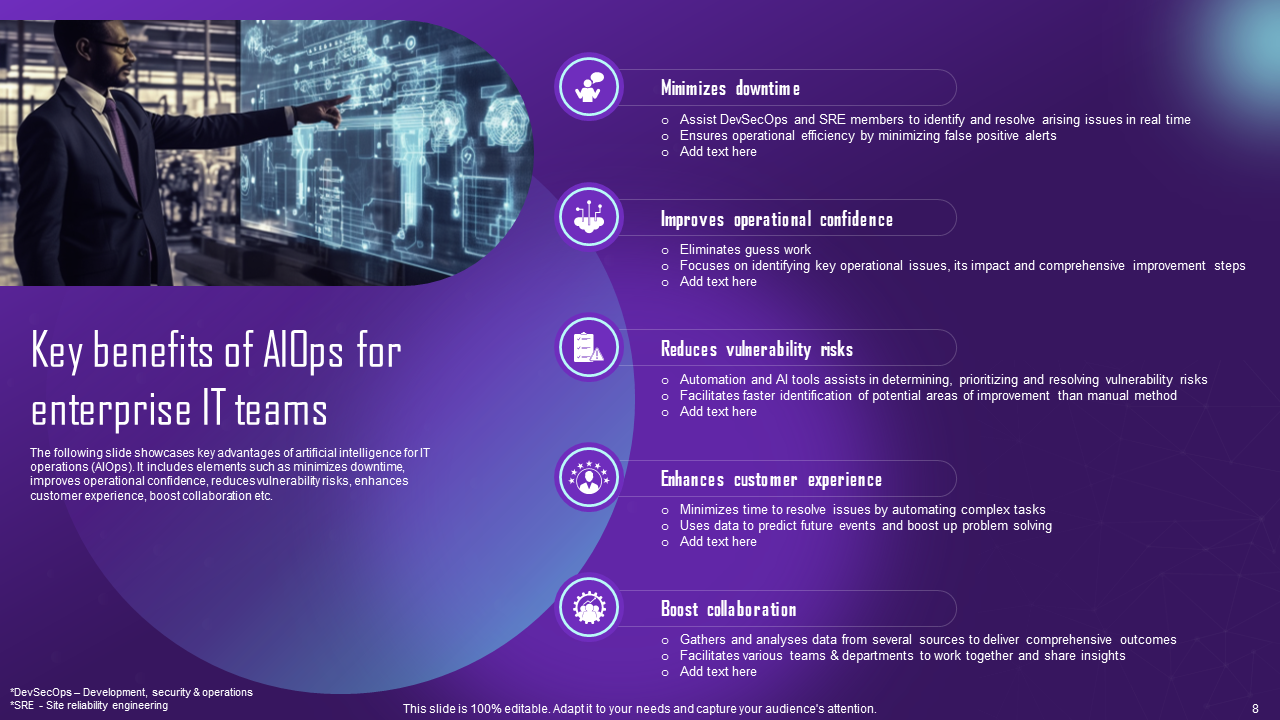
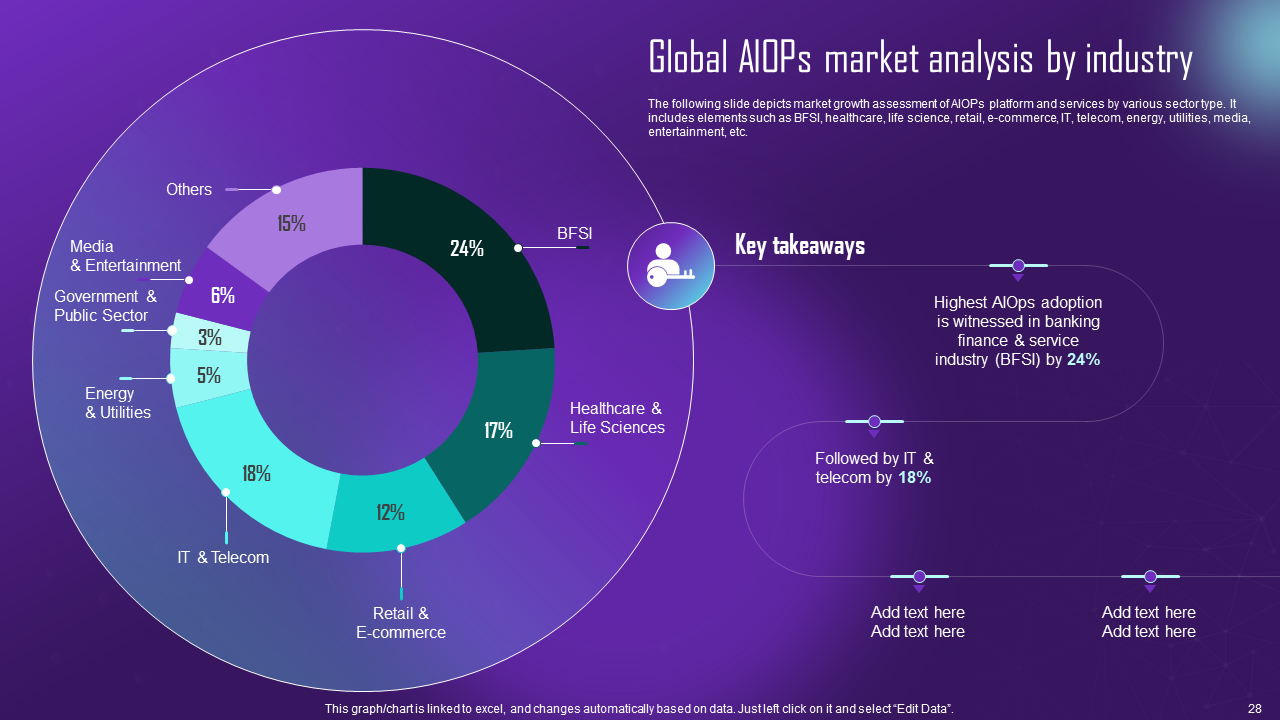
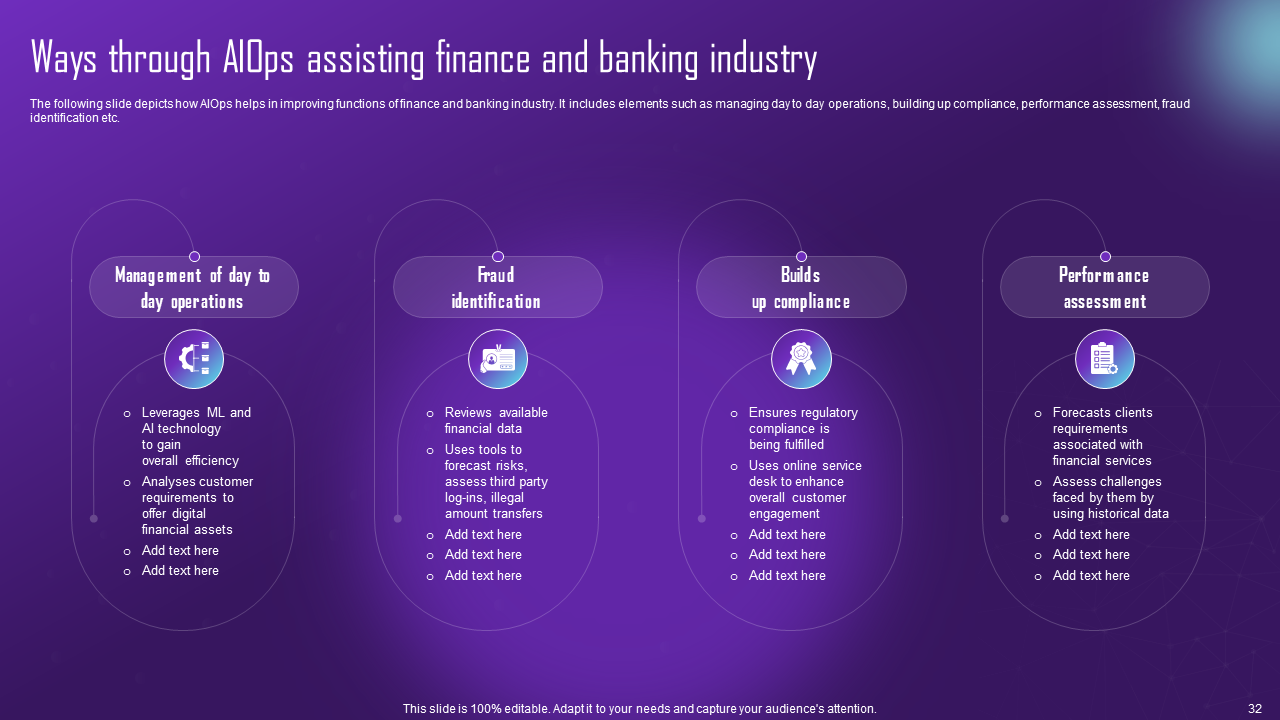
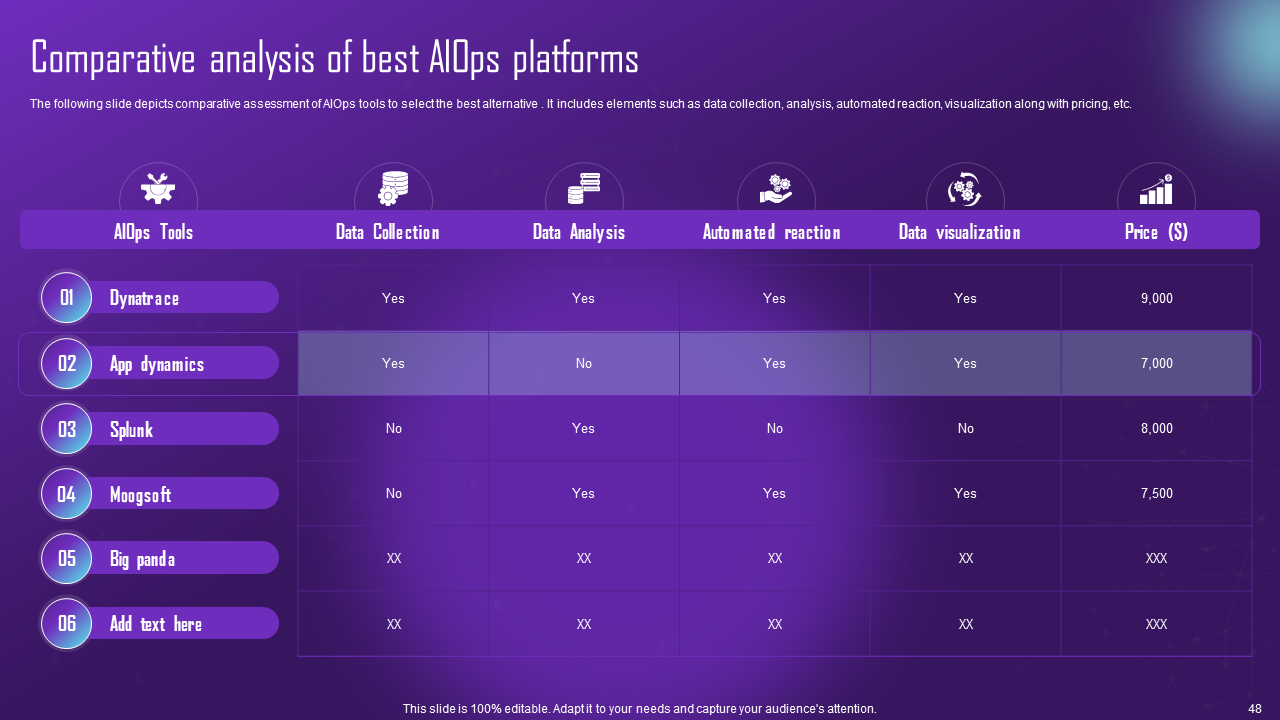
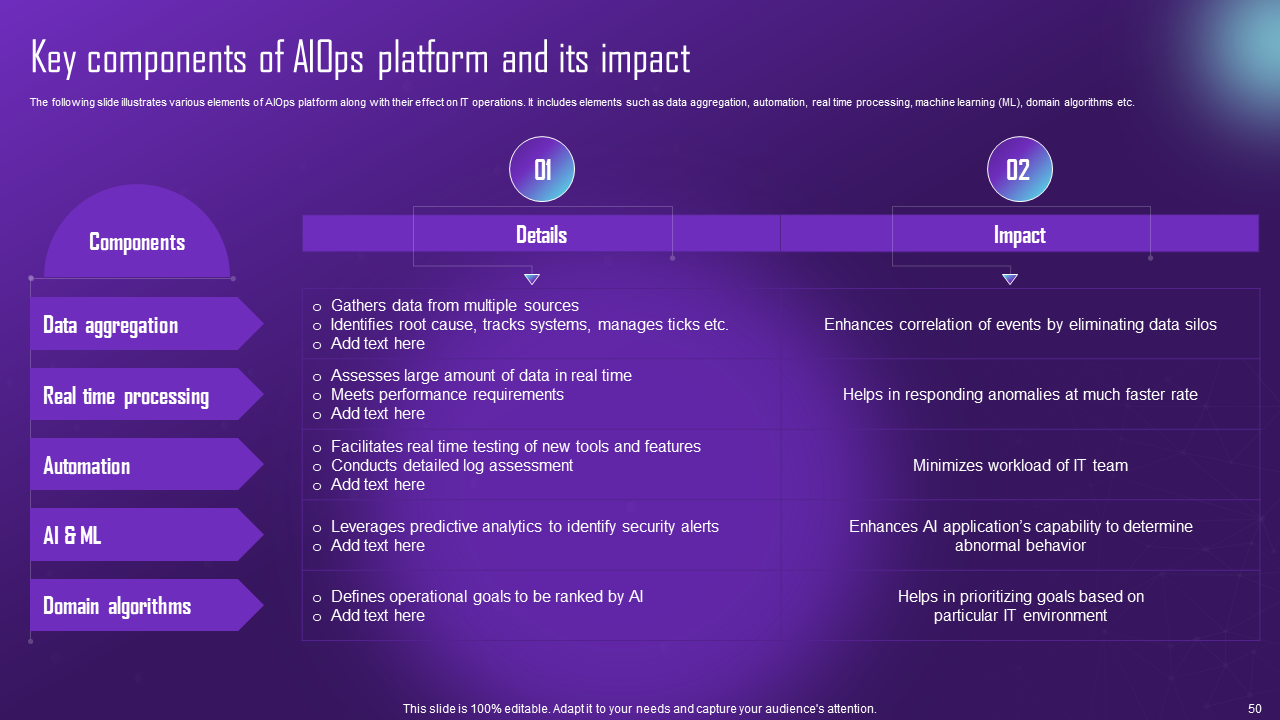



![Everything you need to know about Internet of Things! [Free PPT]](https://www.slideteam.net/wp/wp-content/uploads/2023/10/BANNER-1-1013x441.png)
![Data Mining: A Definitive Guide [Free Template]](https://www.slideteam.net/wp/wp-content/uploads/2023/09/BANNER-9-1013x441.jpg)
![How to Transform Industries: Reinforcement Learning [Free Template]](https://www.slideteam.net/wp/wp-content/uploads/2023/09/BANNER-8-1013x441.jpg)
![TOP 7 SLIDES: Product Launch and Promotional Event Marketing [FREE PPT]](https://www.slideteam.net/wp/wp-content/uploads/2023/10/BANNER-1-1013x441.jpg)











